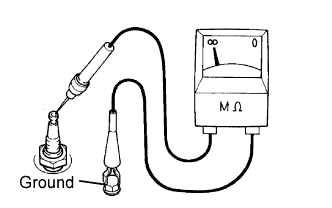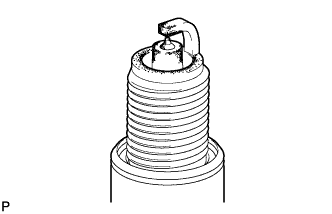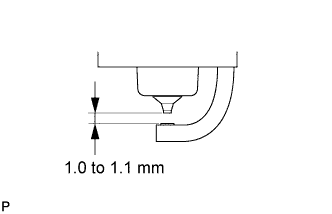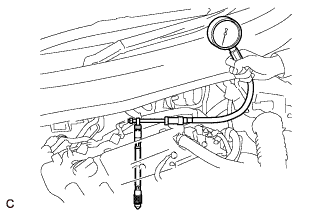Engine -- On-Vehicle Inspection |
| 1. INSPECT ENGINE COOLANT |
- HINT:
| 2. INSPECT ENGINE OIL |
- HINT:
| 3. INSPECT BATTERY |
- HINT:
| 4. INSPECT AIR CLEANER FILTER ELEMENT SUB-ASSEMBLY |
Remove the air cleaner cap.
Remove the air filter element.
Visually check that the air filter is not excessively damaged or oily. If necessary, replace the air filter.
| 5. INSPECT SPARK PLUG |
Check the electrode.
Using a megohmmeter, measure the resistance.
- Standard Resistance:
- 10 MΩ or more
- HINT:
- If a megohmmeter is not available, perform the following simple inspection instead.
 |
Alternative inspection method:
Quickly accelerate the engine to 4000 rpm 5 times.
Remove each spark plug.
Visually check the spark plug.
If the electrode is dry, the spark plug is functioning properly. If the electrode is damp, proceed to the next step.
 |
Check the spark plug for any damage to its threads and insulator.
If there is any damage, replace the spark plug.Recommended Spark Plug Manufacturer Spark Plug Type DENSO SC20HR11
Check the spark plug electrode gap.
- Maximum Electrode Gap for Used Spark Plug:
Electrode Gap 1.3 mm (0.0512 in.)
- Electrode Gap for New Spark Plug:
Electrode Gap 1.0 to 1.1 mm (0.0394 to 0.0433 in.)
 |
Clean the spark plugs.
If the electrode has traces of wet carbon, clean the electrode with a spark plug cleaner and then dry it.- Standard air pressure:
- 588 kPa (6 kgf/cm2, 85 psi)
- Standard duration:
- 20 seconds or less.
- HINT:
- Only use the spark plug cleaner when the electrode is free of oil. If the electrode has traces of oil, use gasoline to clean off the oil before using the spark plug cleaner.
 |
| 6. INSPECT V-RIBBED BELT |
Check the belt for wear, cracks or other signs of damage.
If any of the following defects is found, replace the V-ribbed belt.- The belt is cracked.
- The belt is worn out to the extent that the cords are exposed.
- The belt has chunks missing from the ribs.
- The belt is cracked.
 |
Check that the belt fits properly in the ribbed grooves.
- HINT:
- Check with your hand to confirm that the belt has not slipped out of the groove on the bottom of the pulley. If it has slipped out, replace the V-ribbed belt. Install a new V-ribbed belt correctly.
 |
Check the V belt deflection and tension.
- Deflection:
Item Specified Condition New belt 7.0 to 8.2 mm (0.276 to 0.323 in.) Used belt 7.6 to 10.0 mm (0.299 to 0.394 in.)
- Tension:
Item Specified Condition New belt 700 to 800 N (71 to 82 kg, 157 to 180 lb) Used belt 550 to 750 N (56 to 77 kg, 124 to 169 lb)
- HINT:
- When inspecting the V belt deflection, apply 98 N (10 kgf) tensile force to it.
- After installing a new belt, run the engine for approximately 5 minutes and then readjust the tension to (new belt) specifications.
- Check the V-ribbed belt deflection and tension at the specified point.
- V-ribbed belt tension and deflection should be checked after 2 revolutions of the engine.
- V-ribbed belt tension and deflection should be checked at TDC crank angle and cold condition.
- When adjusting a belt, adjust its deflection and tension to the intermediate values of the specification.
- When reinstalling a belt which has been used for over 5 minutes, adjust its deflection and tension to the used belt specification.
- When using a belt tension gauge, confirm its accuracy by using a master gauge first.
- If using a sonic tension meter:
- Weight:
- 15 g/rib*m
- Width:
- 6 ribs
- Span:
- 188 mm (7.40 in.) (w/ air Conditioning)
- 282 mm (11.1 in.) (w/o air Conditioning)
 |
| 7. INSPECT VALVE AND ADJUSTER NOISE |
Rev up the engine several times. Check that the engine does not emit unusual noises. If unusual noises occur, warm up the engine and idle it for over 30 minutes. Then perform the inspection above again. If any defects or problems are found during the inspection above, perform a lash adjuster inspection (COROLLA_ZRE142 RM000002XR204MX_01_0014.html).
| 8. INSPECT IGNITION TIMING |
When using the Techstream:
Warm up and stop the engine.
Connect the Techstream to the DLC3.
Turn the ignition switch to ON.
Enter Data List Mode on the Techstream.
- HINT:
- Refer to the Techstream operator's manual for further details.
Inspect the ignition timing at idle.
- Ignition timing:
- 8 to 12 degrees BTDC
- NOTICE:
- Turn all the electrical systems and the A/C off.
- Inspect the ignition timing with the cooling fans off.
- When checking the ignition timing, shift the transmission to the neutral position.
Enter the following menus : TC (TE1) / OFF.
Turn the ignition switch off.
Disconnect the Techstream from the DLC3.
When not using the Techstream:
Remove the No. 2 cylinder head cover (COROLLA_ZRE142 RM000002WH607RX.html).
| 9. INSPECT ENGINE IDLE SPEED |
Warm up and stop the engine.
Connect the Techstream to the DLC3.
Turn the ignition switch to ON.
Enter Data List Mode on the Techstream.
- HINT:
- Refer to the Techstream operator's manual for further details.
Inspect the engine idle speed.
- Idle speed:
- 600 to 700 rpm
- NOTICE:
- Turn all the electrical systems and the A/C off.
- Inspect the idle speed with the cooling fans off.
- When checking the idle speed, shift the transmission to either neutral or park.
Turn the ignition switch off.
Disconnect the Techstream from the DLC3.
| 10. INSPECT COMPRESSION |
Warm up and stop the engine.
Remove the No. 2 cylinder head cover (COROLLA_ZRE142 RM000002WH607RX.html).
Remove the 4 ignition coils.
Remove the 4 spark plugs (COROLLA_ZRE142 RM00000304Q017X.html).
Disconnect the 4 fuel injector connectors.
Inspect the cylinder compression pressure.
Insert a compression gauge into the spark plug hole.
Fully open the throttle.
While cranking the engine, measure the compression pressure.
- Compression:
- 1373 kPa (14.0 kgf/cm2, 199 psi)
- Minimum pressure:
- 1079 kPa (11.0 kgf/cm2, 157 psi)
- Difference between each cylinder:
- 98 kPa (1.0 kgf/cm2, 14.2 psi) or less
- NOTICE:
- Use a fully-charged battery so the engine speed can be increased to 250 rpm or more.
- Inspect the other cylinders in the same way.
- Measure the compression in as short time as possible.
If the cylinder compression is low, pour a small amount of engine oil into the cylinder through the spark plug hole, then inspect it again.
- HINT:
- If adding oil increases the compression, the piston rings and/or cylinder bore may be worn or damaged.
- If the pressure stays low, the valve may be stuck or seated improperly, or there may be leakage from the gasket.
 |
Connect the 4 fuel injector connectors.
Install the 4 spark plugs (COROLLA_ZRE142 RM00000304O017X.html).
Install the 4 ignition coils.
- Torque:
- 10 N*m{102 kgf*cm, 7 ft.*lbf}
Install the No. 2 cylinder head cover (COROLLA_ZRE142 RM000002WH407RX.html).
| 11. INSPECT CO/HC |
- HINT:
- This check determines whether or not the idle CO/HC complies with local regulations.
Start the engine.
Run the engine at 2500 rpm for approximately 180 seconds.
Insert the CO/HC meter testing probe at least 40 cm (1.3 ft.) into the tailpipe while idling.
Check the CO/HC concentration during idle and when the engine is running at 2500 rpm.
- HINT:
- When doing the 2 mode (with the engine idling/ running at 2500 rpm) test, the measuring procedures are determined by applicable local regulations.
- If the CO/HC concentration does not comply with local regulations, troubleshoot in the order given below.
Check the A/F sensor and heated oxygen sensor operation.
See the table below for possible causes, then inspect the applicable parts and repair them if necessary.
CO HC Problem Possible Cause Normal High Rough idle - Faulty ignition:
- Incorrect timing
- Fouled, shorted or improperly gapped plugs
- Incorrect valve clearance
- Leakage from intake and exhaust valves
- Leakage from cylinders
Low High Rough idle (Fluctuating HC reading) - Vacuum leaks:
- PCV hoses
- Intake manifold
- Throttle body
- Brake booster line
- Lean mixture causing misfire
High High Rough idle (Black smoke from exhaust) - Restricted air cleaner filter element
- Plugged PCV valve
- Faulty EFI system:
- Faulty pressure regulator
- Faulty engine coolant temperature sensor
- Faulty mass air flow meter
- Faulty ECM
- Faulty injectors
- Throttle body
- Faulty ignition: